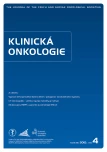Treatment For Volume Upgrading of the Low-Grade Supratentorial Glioma After the Subtotal Neurosurgical Resection
Authors:
F. Třebický 1; J. Kubeš 1; R. Bartoš 2; A. Malucelli 2; M. Sameš 2; M. Navrátil 3; V. Vondráček 3; S. Medková 3; M. Mašek 4; J. Zárubová 5
Authors‘ workplace:
Ústav radiační onkologie, 1. LF UK a Nemocnice Na Bulovce, Praha
1; Neurochirurgická klinika, UJEP a Masarykova nemocnice v Ústí nad Labem
2; Radiofyzikální oddělení, 1. LF UK a Nemocnice Na Bulovce, Praha
3; Radiodiagnostická klinika, 1. LF UK a Nemocnice Na Bulovce, Praha
4; Neurologická klinika, Thomayerova nemocnice, Praha
5
Published in:
Klin Onkol 2012; 25(4): 294-298
Category:
Case Reports
Overview
Background:
Low-grade gliomas WHO II (LGG) are mostly detected in patients with neurological symptomatology between 20 and 45 years of age very often as secondary epilepsy. We present two cases in which low-grade gliomas attacked neurological zones. Neurosurgical resection was subtotal because of the risk of the damage in neurocognitive functions in both these patients. After the operation, both patients were followed at neurosurgery department in regular intervals using different imaging methods (MRI, MRS and PET). After resections, the MRI detected the enlargement of the volumes of the tumor residua in both patients.
Patients and methods:
Owing to the risk of up-grading to high-grades glial tumors (overexpression of EGFR and VEGF), both patients were indicated for curative treatment by external beam radiotherapy combined with chemotherapy (Temodal®) and adjuvant chemotherapy.
Results:
After the end of this treatment, the MRI proved considerable partial regressions in both patients. Moreover, three months later, the MRI did not prove any residual disease.
Conclusion:
Radiotherapy combined with the administration of Temodal should prolong the OS and TTP in patients with a high risk of up-grading of low-grade gliomas of the brain. Both the patients are in a follow-up program, also because of the risk of duplicite brain tumor.
Key words:
brain tumor – glioma – tumor grading – chemotherapy – temozolomide – radiotherapy
The authors declare they have no potential conflicts of interest concerning drugs, products, or services used in the study.
The Editorial Board declares that the manuscript met the ICMJE “uniform requirements” for biomedical papers.
Submitted:
7. 12. 2011
Accepted:
27. 7. 2012
Sources
1. Grier J, Batchelor T. Low-Grade Gliomas in Adults. The Oncologist 2006; 11(6): 681–693.
2. Pignatti F, van den Bent M, Curran D. European Organization for Research and Treatment of Cancer Brain Tumor Cooperative Group; European Organization for Research and Treatment of Cancer Radiotherapy Cooperative Group. Prognostic Factors for Survival in Adult Patients With Cerebral Low-Grade Glioma. J Clin Oncol 2002; 15(20): 2076–2084.
3. Combs SE, Thilmann C, Edler L et al. Efficacy of Fractionated Stereotactic Reirradiation in Recurrent Gliomas: Long-Therm Results in 172 Patients Treated in a Single Institution. J Clin Oncol 2005; 23(34): 8863–8869.
4. Shaw E, Arusell R, Scheithauer B et al. Prospetive Randomized Trial of Low – Versus High-Dose Radiation Therapy in Adults With Supratentorial Low-Grade Glioma: Initial Report of a North Central Cancer Tratment Group//Radiation Therapy Oncology Group/Eastern Cooperative Oncology Group Study. J Clin Oncol 2002; 20(9): 2267–2276.
5. van Veelen M L, Averzaat CJ, Kros JM et al. Supratentorial low grade astrocytoma: prognostic factors, dedifferentiation, and the issue of early versus late surgery. J Neurol Neurosurg Psychiatry 1998; 64(5): 581–587.
6. Shafgat S, Hedley-Whyte ET, Henson JW. Age-dependent rate of anaplatic transformation in low-grade astrocytoma. Neurology 1999; 52(4): 867–869.
7. Bauman G, Fisher B, Watling C. Adult Supratentorial Low-Grade Glioma: Long-Therm Experience at a Single Institution. Int J Radiat Biol Phys 2009; 75(5): 1401–1407.
8. Perez CA, Brady LW (eds). Priciples and practice of radiation oncology. Philadelphia: JB Lippincott Williams & Wilkins 2008: 737–740.
9. van den Bent MJ, Afra D, de Witte O et al. EORTC Radiotherapy and Brain Tumor Groups and the UK Medical Research Council. Long-term efficacy of early versus delayed radiotherapy fo low-grade astrocytoma and oligodendroglioma in adults: the EORTC 22845 randomised trial. Lancet 2005; 366(9490): 985–990.
10. Stupp R, Hegi E, Gilbert MR et al. Chemoradiotherapy in Malignant Glioma: Standard of Care and Future Directions. J Clin Oncol 2007; 25(26): 4127–4136.
11. Stupp R, Gander M, Leyvraz S et al. Current and future development in the use temozolomide for the treatment of brain tumors. Lancet Oncol 2001; 2(9): 552–560.
12. Pace A, Vidiri A, Galiè E et al. Temozolomide chemotherapy for progressive low-grade glioma: clinical benefits and radiolobiological response. Ann Oncol 2003; 14(12): 1722–1726.
Labels
Paediatric clinical oncology Surgery Clinical oncologyArticle was published in
Clinical Oncology

2012 Issue 4
- Metamizole vs. Tramadol in Postoperative Analgesia
- Metamizole at a Glance and in Practice – Effective Non-Opioid Analgesic for All Ages
- Possibilities of Using Metamizole in the Treatment of Acute Primary Headaches
- Current Insights into the Antispasmodic and Analgesic Effects of Metamizole on the Gastrointestinal Tract
- Spasmolytic Effect of Metamizole
Most read in this issue
- Hepatocellular Carcinoma – Long-Term Treatable Disease
- EGFR Mutations in Patients with Advanced NSCLC
- Treatment For Volume Upgrading of the Low-Grade Supratentorial Glioma After the Subtotal Neurosurgical Resection
- CT Colonography – Evolution of Methodology and Indications
